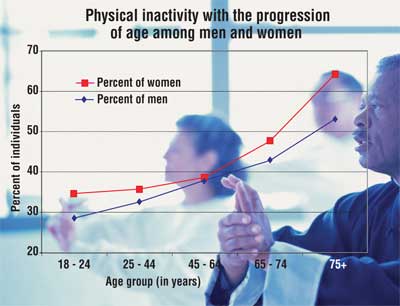US Pharm. 2006;12:8.
Although scientific advances enable the effective diagnosis and treatment of many ailments, healthy behavior is essential to further enhance treatment. Health promotion and disease prevention objectives were first published in the United States in 1980; specific goals were established in 1990 and have been revised for 2010. The CDC monitors the progress of efforts to remain healthy, while data from the National Health Interview Survey document the outcomes of health promotion and disease prevention efforts. These rates are taken from the latest data published, reported from 2002 to 2004.
In the U.S., 20% of all adults had five or more drinks in one day at least once in the past year; 20% were current cigarette smokers, and about 40% were physically inactive in their leisure time. These percentages significantly exceed the 25% of adults who are obese and about 30% of adults who sleep an average of six hours or less per day. Compared to women, men were more than twice as likely to consume five or more drinks in one day. Men were also more likely to be current smokers, but the differences were not nearly as striking as for alcohol use. However, men had lower rates of physical inactivity than women did.

Rates of Physical Activity
Overall, 38% of
adults did not engage in any light, moderate, or vigorous leisure-time
physical activity. About one in eight adults (11.8%) participated in vigorous
physical activity at least five times per week.
Age: The rate of leisuretime physical activity declined with age, from 68.6% among those ages 18 to 24, to 40.2% of adults 75 and older.
Race: White adults (63.7%) and Asian adults (62.1%) were more likely than black adults (51.3%) to engage in at least some leisure-time physical activity. Non-Hispanic white adults (66.1%) were more likely than Hispanic adults (47.6%) to engage in at least some physical activity.
Education: Rates of leisure-time physical activity increased with level of education. Adults with a graduate degree were about twice as likely as adults with less than a high school diploma to engage in at least some leisure-time physical activity and were more likely to be regularly active. Adults with an advanced academic degree (39.2%) were more than three times as likely as adults with less than a high school diploma (11.8%) to engage in leisure-time strengthening activities.
Income: The prevalence of physical activity increased with family income. Adults with family incomes four times the poverty level (or more) were more likely to engage in light/moderate leisure-time physical activity at least five times per week, compared to adults with family incomes below the poverty level.
Marital Status: Married women (62.4%) were more likely than women in most other marital status groups to engage in at least some leisure-time physical activity. Widowed adults (24.5%) were less likely than never-married adults (33.1%), married adults (31.3%), and divorced or separated adults (29.4%) to engage in regular physical activity.
To comment on this article, contact editor@uspharmacist.com.






